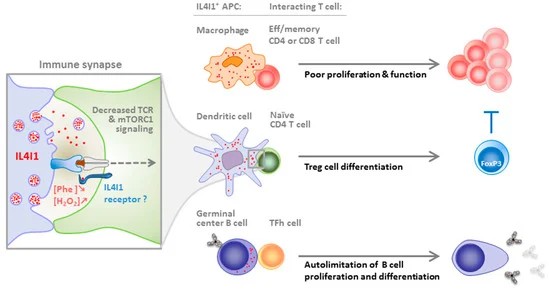Immunometabolism, the intricate interplay between metabolic processes and the immune system, has emerged as an exciting research domain over the last decade. As immunotherapy becomes a significant therapeutic strategy in the oncology landscape, understanding the metabolic-immune checkpoints could pave the way for more effective treatments. Among several targets of interest, Interleukin-4 Induced Gene 1 (IL4I1) holds considerable promise.
Creative Biolabs delves into the function, mechanism, and therapeutic potential of IL4I1 in battling diseases such as cancer.
IL4I1, a L-phenylalanine oxidase secreted by antigen-presenting cells, is involved in the metabolic regulation of immune responses. Originally identified in B cells exposed to IL-4, IL4I1 is also detectable in T cells, macrophages, dendritic cells, myeloid cells, and fibroblasts, suggesting a broader function within the immune system.
As a metabolic checkpoint, IL4I1 takes part in the delicate balance control of the immune system, efficiently bridging metabolism and the immune responses.
The IL4I1 protein consists of a signal peptide, a copper-binding site, and a FAD-binding domain. The active site of IL4I1 contains a copper ion that plays a crucial role in its enzymatic activity. This unique structure endows IL4I1 with the ability to catalyze the oxidation of l-amino acids, particularly phenylalanine, leading to the production of reactive oxygen species (ROS) and ketoacids.
IL4I1's metabolic functions extend beyond conventional immune modulation. By depleting essential amino acids, particularly phenylalanine, IL4I1 influences T-cell proliferation and activation. Moreover, the production of ROS during the enzymatic reaction contributes to the local redox environment, further shaping the immune milieu.
 Fig. 1 Regulation of the immune response by IL4I1.1,2
Fig. 1 Regulation of the immune response by IL4I1.1,2
By co-opting metabolic pathways for suppressing immune response, IL4I1 indicates an exciting intersection of cellular metabolism and immune regulation, signifying the exploitation of metabolic checkpoints as novel therapeutic strategies. As we advance and deepen our understanding of IL4I1, we perceivably move towards the development of better, more precise immune-modulating treatments for cancer and autoimmunity.
Research into metabolic immune checkpoints such as IL4I1 is relatively nascent, yet they suggest promising avenues for innovative immunotherapies. Creative Biolabs is at the forefront of immune checkpoint research, contributing to the broader understanding and application of metabolic immune checkpoints like IL4I1.
References
All listed customized services & products are for research use only, not intended for pharmaceutical, diagnostic, therapeutic, or any in vivo human use.
USA
Tel:
Fax:
Email:
Copyright © 2025 Creative Biolabs. All Rights Reserved.